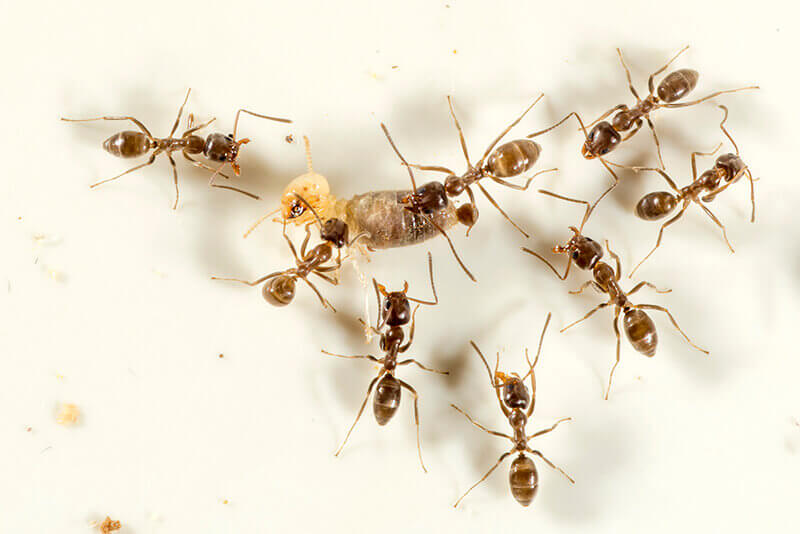February 19, 2018
Death by termite: Purdue entomologist uses natural cravings to control invasive ants
 Argentine ants attack a fipronil-treated termite prey. Lab and field tests show that prey-baiting is an effective method for controlling invasive ants and requires far less insecticides than traditional control methods. (Purdue Entomology photo by John Obermeyer)
Download image
Argentine ants attack a fipronil-treated termite prey. Lab and field tests show that prey-baiting is an effective method for controlling invasive ants and requires far less insecticides than traditional control methods. (Purdue Entomology photo by John Obermeyer)
Download image
WEST LAFAYETTE, Ind. - Poisonous baits are designed to smell and taste like foods that pest insects might want to consume, with varying degrees of success in controlling the pests. But a Purdue University entomologist has found a better way — giving the insects exactly what they want rather than a knock-off.
Grzegorz Buczkowski, a research associate professor in the Department of Entomology, coated termites with poison and set them free near colonies of invasive ants in South Africa. Over three weeks, nearly every ant was killed and Buczkowski used far less insecticide than traditional control methods.
“All ants eat protein to grow, and they usually get it by preying on insects,” said Buczkowski, whose findings were published in the Journal of Applied Entomology. “We are feeding them what they want and getting better results.”
There are invasive ant species on nearly every continent, often brought from their native countries to others in the holds of ships. The Argentine ant, for example, came from Argentina to the United States more than a century ago in soil used as ballast on ships. When the ships arrived in Louisiana, they dumped the soil to load up on cargo, and the ants started to spread, reaching much of the southern portion of the country.
Argentine ants outcompete many other species, disrupting ecological interactions. They also consume secretions from crop pests, such as aphids. In return, they protect those pests from natural predators, allowing their populations to grow.
It’s the Argentine ants’ ability to dominate other species that makes Buczkowski’s control method so effective.
“Argentine ants are highly aggressive and competitive. It’s why they can outcompete native ants,” Buczkowski said. “But that works against them. When you put out termites, Argentine ants are the first to find them. They take these termites back to the nest and poison the whole colony.”
 Grzegorz Buczkowski
Grzegorz Buczkowski
Download image
In field tests in South Africa, Buczkowski created six 100-square-meter plots and released termites coated in fipronil, a broad-spectrum insecticide. In four plots, 100 percent of ants were eradicated within 21 days. In the other two, nearly 98 percent of the ants were killed.
Fipronil is often used in other forms, but those require far more of the poison to control the same area. It would take 2,644 times more liquid spray, and 16,158 times more granules to cover 100 square meters. Those forms are spread on the ground, and insects not meant to consume the poisons can also be killed.
The termites have another advantage over other forms of poisons. Granules, gels and sprays only affect the worker ants that come into contact with or consume them.
But the worker ants can’t digest termites themselves. Instead, they use a process called trophallaxis. They take the termites back to their nests and feed them to larvae, which pre-digest the insect and feed it back to the workers. The larvae, the workers and the queens, who receive the predigested termites from workers, are all poisoned.
“With some baits you kill off the workers, but you still have queens and broods, and a few weeks later you have a new generation,” Buczkowski said. “With this, you’re stopping the colony from reproducing.”
While the termites die within an hour of being painted with fipronil, Buczkowski isn’t recommending setting termites loose near homes or other buildings to control ant populations. He sees the method as an effective way to control invasive ant populations in large natural areas that contain colonies with millions of ants.
Future research will include testing other poisons, as well as different bait insects and other species of invasive ants. Since ants tend to want fresh prey, Buczkowski is experimenting with freeze-dried termites that look fresh but could be pre-treated and taken to field areas to kill ants.
Purdue University’s Center for Urban and Industrial Pest Management and the Industrial Affiliates Program funded the research.
Contact: Brian Wallheimer, 765-532-0233, bwallhei@purdue.edu
Source: Grzegorz Buczkowski, 765-494-6314, gbuczkow@purdue.edu
ABSTRACT
Let them eat termites—prey- baiting provides effective control of Argentine ants, Linepithema humile, in a biodiversity hotspot
G. Buczkowski1, N. P. Mothapo2 and T. C. Wossler2
1. Department of Entomology, Purdue University, West Lafayette, IN
2. Department of Botany and Zoology, Stellenbosch University, Stellenbosch, South Africa
Invasive ants threaten biodiversity, ecosystem services and agricultural systems. This study evaluated a prey- baiting approach for managing Argentine ants in natural habitat invaded by Argentine ants. Blackmound termites (Amitermes hastatus) were topically exposed to fipronil and presented to Argentine ants (Linepithema humile). In laboratory assays, L. humile colonies were offered fipronil- treated termites within experimental arenas. The termites were readily consumed, and results demonstrate that a single termite topically treated with 590 ng fipronil is capable of killing at least 500 L. humile workers in 4 days. Field studies were conducted in natural areas invaded by L. humile. Fipronil-treated termites scattered within experimental plots provided rapid control of L. humile and ant densities throughout the treated plots declined by 98 ± 5% within 21 days. Results demonstrate that the prey- baiting approach is highly effective against L. humile and may offer an effective alternative to traditional bait treatments. Furthermore, prey-baiting offers environmental benefits by delivering substantially less toxicant to the environment relative to current control methods which rely on commercial bait formulations and may offer greater target specificity.
Agricultural Communications: (765) 494-8415;
Darrin Pack, Manager/Media Relations and Public Information, dpack@purdue.edu
Agriculture News Page

